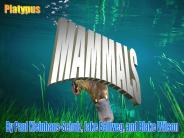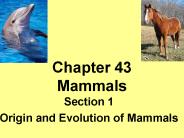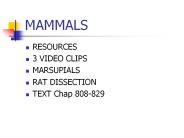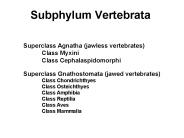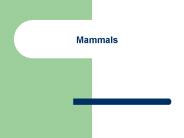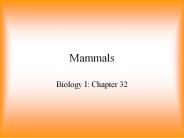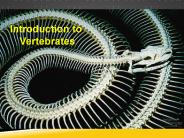Monotremes PowerPoint PPT Presentations
All Time
Recommended
MONOTREMES Egg laying Duckbilled Platypus Anteater Echidna MARSUPIALS Premature babies develop in pouch Found in Australia/New Guinea Kangaroo Wallaby ...
| PowerPoint PPT presentation | free to download
... kangaroo, wallaby, bandicoot, quokka, quoll, tasmanian devil, tasmanian tiger. About 280 species ... marsupial populations. Tasmanian Tiger. Diprotodon ...
| PowerPoint PPT presentation | free to view
Prototheria (monotremes) Metatheria (marsupials) The 3 subclasses of mammals differ strikingly in their modes of reproduction Eutheria (placentals)
| PowerPoint PPT presentation | free to view
These mammals are classified as Monotremes. ... They are the only mammals that lay eggs rather than give birth. CHARACTERISTICS. Mammal ...
| PowerPoint PPT presentation | free to view
Phylum and Subclasses Phylum: Mammalia Subclasses: Monotremes Lay eggs Marsupials Very immature young, females usually have pouches Placentals Develop young in ...
| PowerPoint PPT presentation | free to download
Monotremes 'Spiny Anteaters' (egg-laying) BIRDS & MAMMALS. Monotremes ... 5. Egg laying mammals ... The Tasmanian devil. the largest carnivorous ...
| PowerPoint PPT presentation | free to view
Australia - Habitaci n Presentaci n Jeanine Carr Australia Australia Los marsupios Los monotremes Monotremes are primitive, egg-laying mammals.
| PowerPoint PPT presentation | free to download
... with a tropical climate Fauna In its wildlife can find different types of marsupials like koalas and kangaroos, monotremes, animals such as ...
| PowerPoint PPT presentation | free to download
Abdominal cavity in monotremes, elephants, whales and non-mammals ... Claspers in elasmobranchs modified pelvic fin. Copulatory Organs ...
| PowerPoint PPT presentation | free to view
f. Mammals: Reptile to Mammal' transitions - deep history: Pelycosaurs. Therapsids ... g. Mammals: - Development: - Lay eggs (Monotremes) - birth (Marsupials) ...
| PowerPoint PPT presentation | free to view
... Most successful group of mammals Placental Mammals Competitive advantage over monotremes and marsupials Better nutrition from ... Canine Premolars ...
| PowerPoint PPT presentation | free to view
Human embryo (5 weeks) Notochord attachment site for muscles ... Platypus. P. Chordata. Mammalia. Monotremes. Echidna. P. Chordata. Mammalia. Marsupials ...
| PowerPoint PPT presentation | free to view
Phylum Chordata (the Chordates) includes both invertebrates and vertebrates that ... Monotremes (Example: duck-billed platypus) Egg-laying mammals ...
| PowerPoint PPT presentation | free to view
Mammals can be found on. every continent, Mammals can be ... barracuda. human. GROUPS OF MAMMALS. Monotremes. Marsupials. Placentals. Short-beaked echidna ...
| PowerPoint PPT presentation | free to view
Notochord: longitudinal, flexible rod located between the ... Monotremes (egg-laying): platypus; echidna. Marsupials (pouch): opossums, kangaroos, koalas ...
| PowerPoint PPT presentation | free to view
Four ways birds are adapted for flight. Bones of a bird's forelimbs form wings ... There are two species of monotremes: spiny anteaters and duck-billed platypus. ...
| PowerPoint PPT presentation | free to view
Evolution of Australian Biota Identify and describe evidence that Australia was once part of Gondwana Together with New Guinea, it is the only place where monotremes ...
| PowerPoint PPT presentation | free to view
The most familiar type of monotremes today are the duckbilled platypus and the spiny anteater. ... include animals such as sloth's, anteaters, and armadillos. ...
| PowerPoint PPT presentation | free to view
... this area before exiting the body in reptiles, amphibians, birds, and monotremes. ... mouth of reptiles which detects odors. Vocab. 400. A: What is a bipinnaria? ...
| PowerPoint PPT presentation | free to view
Chapter 43 Mammals Section 1 Origin and Evolution of Mammals Characteristics Endothermy- regulate own body temperature- metabolism Hair- all mammals have some hair ...
| PowerPoint PPT presentation | free to view
... rhinoceros, & tapirs Location: Africa & Asia Have a cecum Order Cetacea Whales, dolphins, porpoises Lack hind-limbs, have tails Totally aquatic, ...
| PowerPoint PPT presentation | free to view
Figure 34.2 Echinodermata Cephalochordata ANCESTRAL DEUTEROSTOME Chordates Urochordata Notochord Myxini Craniates Common ancestor of chordates Petromyzontida
| PowerPoint PPT presentation | free to view
Chapter 34 Phylum Hemichordata- Acorn Worms Have three body regions: proboscis, collar, and trunk Have both a ventral and dorsal nerve cord anterior portion of dorsal ...
| PowerPoint PPT presentation | free to view
Title: PowerPoint Presentation Last modified by: Box User Document presentation format: Custom Other titles: Gill Sans ProN W3 Arial Calibri Comic ...
| PowerPoint PPT presentation | free to download
... spiny anteaters Both the reproductive system and the urinary system open into a cloaca that is similar to the ... Jaw joint Jaw joint Wolf Horse Feeding ...
| PowerPoint PPT presentation | free to view
MAMMALS RESOURCES 3 VIDEO CLIPS MARSUPIALS RAT DISSECTION TEXT Chap 808-829 MEDIUM 1. Name 5 marsupials. 2. I m a pinneped with great legs and a dog like face.
| PowerPoint PPT presentation | free to download
... hippos, not pigs. Hippos grouped w/ pigs. Artiodactyla. 2 or ... pigs, peccaries & hippopotami: most primitive, regrouped. Suborder Tylopoda: camels & llamas ...
| PowerPoint PPT presentation | free to view
Chordates An Introduction Kingdom Animalia- All inverts & verts Phylum Chordata: All have nerve cords. 3 subphyla : A- Urochordata (tunicates aka sea squirts).
| PowerPoint PPT presentation | free to download
Title: Slide 1 Author: Laptop User Last modified by: jcarr Created Date: 8/18/2003 6:25:55 PM Document presentation format: On-screen Show Company
| PowerPoint PPT presentation | free to download
amoebas that often use pseudopodia for food capture and locomotion ... Naegleria fowleri: a free living amoeba found in lakes and ponds that can cause ...
| PowerPoint PPT presentation | free to download
A Beaver. 5/25/09. What is a Mammal. 14. Is this a Mammal? A Lady Bug. 5/25/09. What is a Mammal ... YES. Lady Bug. NO. YES. Beaver. NO. YES. Spider. No. Yes ...
| PowerPoint PPT presentation | free to view
Mammals Characteristics of Mammals 3 Middle Ear Bones malleus, incus, and stapes (hammer, anvil, and stirrup) the first two derived from the ancestral jaw.
| PowerPoint PPT presentation | free to view
The Animal Kingdom : The Chordates Day 3 Recall: All chordates have a notochord during their embryological development that usually turns into a spinal column.
| PowerPoint PPT presentation | free to view
... kangaroo Koala Wallaby ... short as or shorter than length of estrus cycle ... due to Red Kangaroo: Diet: Herbivore Average life span ...
| PowerPoint PPT presentation | free to view
Chapter 34 Chordates
| PowerPoint PPT presentation | free to download
THIS With THIS With The Final Jeopardy Category is: Skeletal Lab Please record your wager. Click on screen to begin What were the two divisions of the ...
| PowerPoint PPT presentation | free to download
MAMMALS. This is a mini lesson about mammals. ... An example of a monotreme is a duckbilled platypus. Next. What are placental mammals? ...
| PowerPoint PPT presentation | free to view
Down Syndrome Author: Carey Williams Last modified by: trace_r Created Date: 10/9/2006 10:38:45 PM Document presentation format: On-screen Show (4:3) Company: OVJHS
| PowerPoint PPT presentation | free to view
Chapter 34 The Origin and Evolution of Vertebrates
| PowerPoint PPT presentation | free to view
Genomic Imprinting Tradeoffs in communication between maternal and paternal genetic effects Genomic Imprinting Differential expression of genes depending on parental ...
| PowerPoint PPT presentation | free to view
Overview of Vertebrates Kingdom Animalia Phylum Chordata (Lancelets, tunicates) Sub-Phylum Vertebrata Class Myxini Class Cephalaspidomorphi Class Chondrichthyes
| PowerPoint PPT presentation | free to view
Infer Why might sexual reproduction, as opposed to asexual reproduction, produce a population better able to survive disease or environmental changes
| PowerPoint PPT presentation | free to view
Nourishment of newborn with milk. Close mother-offspring bond. Evolved in association WITH dyphylodont teeth ... Platypus: only left ovary functional (as in birds) ...
| PowerPoint PPT presentation | free to view
... wombat 250 species pouched mammals Show Koala video here Koala Bear Tasmanian Devil Flying Phalangers Wombat opossum Kangaroo young born very helpless after ...
| PowerPoint PPT presentation | free to download
... are the only marsupials outside the Australian region. ... There may be as many as 24 separate orders of placental animals. To what order do we belong? ...
| PowerPoint PPT presentation | free to view
Mammals Biology I: Chapter 32
| PowerPoint PPT presentation | free to download
Amniotes through Eutherians Chapter 34.6-34.8 By: Francisco Berrios and Siria Arzuaga Amniotes A group of tetrapods that trace back to the same common ancestor.
| PowerPoint PPT presentation | free to download
The fastest mammal (also the fastest land animal) it the Cheetah. The cheetah runs between 60 and 70 miles per hour. The Slowest Mammal ...
| PowerPoint PPT presentation | free to view
Trunk divided into thoracic and abdominal cavities by diaphragm ... yak 'man of the forest' orangutan. largest monkey. mandrill. largest herds. springbok ...
| PowerPoint PPT presentation | free to view
Introduction to Vertebrates
| PowerPoint PPT presentation | free to download
Vertebrates Emily Reiss Josie Jacob-Dolan Tori Willbanks-Roos
| PowerPoint PPT presentation | free to view
Chapter 30-32 Nonvertebrate Chordates, Fishes & Amphibians Reptiles & Birds Mammals Unit 9--Vertebrates
| PowerPoint PPT presentation | free to download
SC.F.2.2.1 Knows that many characteristics of an organism are inherited from the parents of the ... and amphibians. Mammal Characteristics All mammals are warm ...
| PowerPoint PPT presentation | free to download
Includes most mammals we think about - whales, bats, elephants, shrews, and armadillos ... 6' at shoulder; could kill a modern elephant. Big guys ...
| PowerPoint PPT presentation | free to view
Mammals. 17-2. Mammal Characteristics. Mammary Glands. Secrete milk. Females supply milk to young ... Require lots of energy from food. Mammal Characteristics ...
| PowerPoint PPT presentation | free to view





